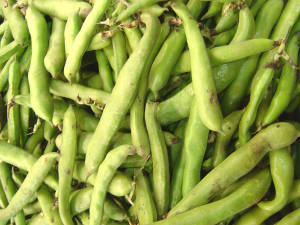Broad beans, otherwise known as Fava or Faba beans, are a source of vitamins and fiber. They are most often used in Asian, African and middle-eastern cooking, and can be fried, boiled or eaten raw.
Planting Broad Beans
Broad beans are able to be grown through wet, cool winters without any difficulty. As long as the weather remains cool they are an exceedingly easy plant to grow. They like a protected site with plenty of sunlight. Dig in rotted organic matter a month before sowing, or even better, use a site that was manured for another crop. A general fertilizer can be added a week before sowing, but avoid one high in nitrogen. pH should be between 6 and 7. The type of soil doesn’t matter too much, but it should at least be able to retain moisture.
Plant seeds one to two inches deep (2.5-5cm) and 6 inches apart (15cm) with rows 8 inches (20cm) apart. Soil should be damp when sowing.
Growing Broad Beans
Broad beans do not need water until seedlings emerge. Mulch to maintain moisture and weed.
Broad bean plants need some sort of trellis. Use a stake and some gardening ties to support plants. Towards maturity, stop plants by pinching the growing point at the top of the plant. This will ensure that the plant’s energy is used to grow the pods.
Growing broad beans in containers is possible for smaller varieties. Containers should be 10 inches (25cm) deep. Sow seeds with the spacing mentioned above and water regularly.
Harvesting Broad Beans
Towards maturity, the beans will begin to show through the pods. You will want to pick them before they split open entirely. Use a sharp knife or scissors to remove the pods. The earlier the pods are harvested the tastier the pods are. Beans harvested later need to be shelled for the beans.
Broad beans can be frozen in air-tight bags after blanching for 3 minutes.
Threats to Broad Beans
Aphids are the biggest annoyance, as well as a few leafy fungal diseases.

